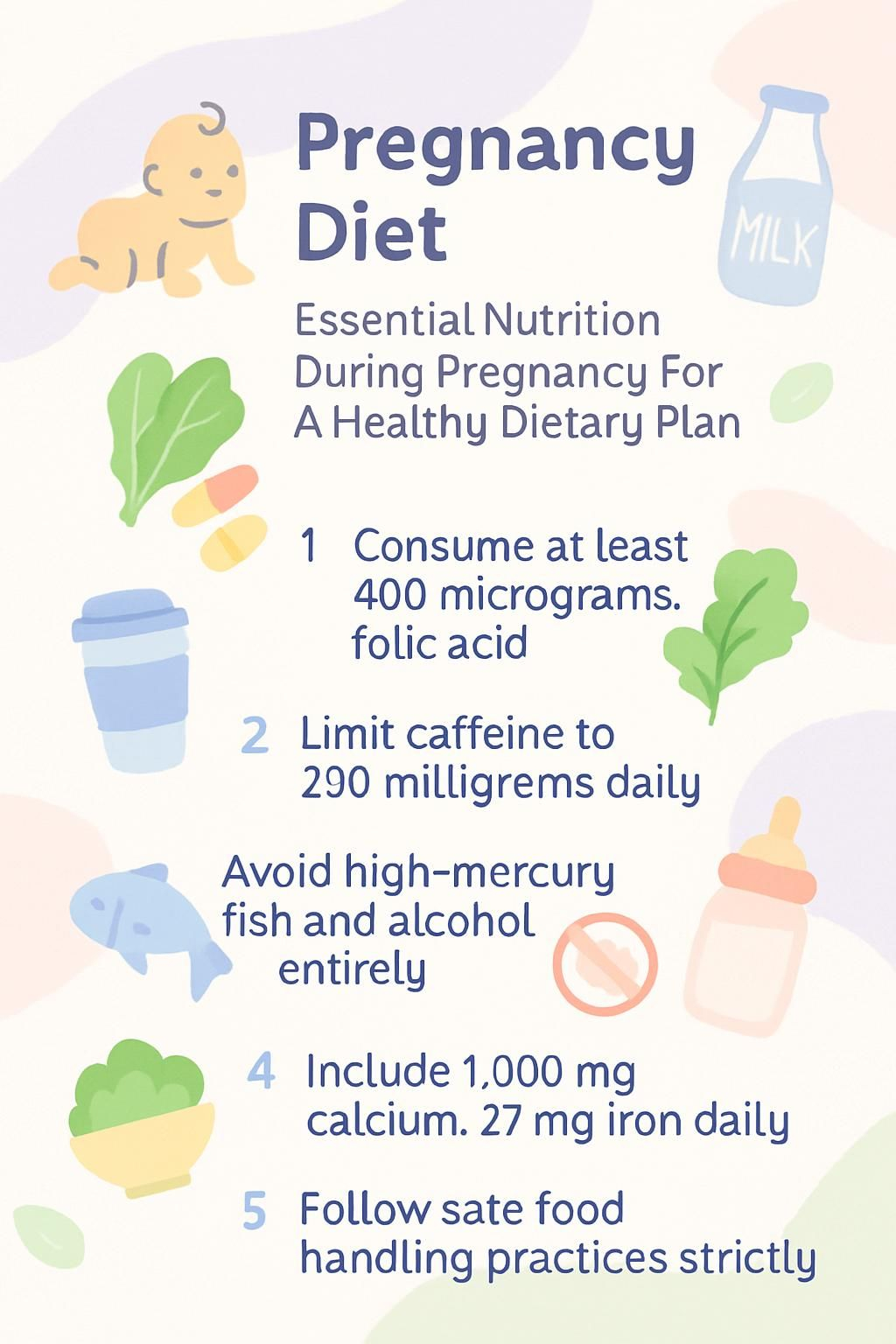Pregnancy Diet: Essential Nutrition During Pregnancy For A Healthy Dietary Plan
Our Nutrition Assistant AI Suite will transform your body. You will lose fat, get toned, and build muscle. Gain confidence and optimal health.
Sorting through advice can feel exhausting. Clear guidance helps you make confident food choices. A smart pregnancy diet supplies the nutrients your body and your baby need for steady growth. Good nutrition during pregnancy can lower risks, support healthy weight gain, and make daily life easier.
This guide explains the essentials, what to eat and what to limit, and how to build a simple plan you can stick with. You will find practical steps, safe food handling tips, and a short look at prenatal vitamins. Use what fits your life, then check in with your care team.
Key Takeaways
- Take at least 400 micrograms of folic acid daily to reduce neural tube defects by up to 70 percent, as advised by the U.S. Department of Health and Human Services.
- A balanced plan includes calcium 1,000 mg per day, iron 27 mg per day, protein 71 grams per day, vitamin D 600 IU per day, plus omega-3 sources like salmon.
- Avoid high-mercury fish such as shark or swordfish, unpasteurized dairy, raw or undercooked meats, added sugars, saturated fats, and any alcohol during pregnancy.
- Limit caffeine to no more than 200 milligrams per day, about one 12-ounce cup of coffee.
- Handle food safely: wash produce under running water, cook meat to USDA temperatures, and choose only pasteurized dairy to prevent infection.

Nutrition During Pregnancy: Key Concepts and Benefits

Think of your meals as fuel for two bodies working as one. Balanced choices help your baby’s organs form, and they support your energy, mood, and sleep.
How Does a Balanced Diet Support Fetal Development?
A balanced diet gives the vitamins and minerals needed for growth. Aim for variety from every food group. Key nutrients include folic acid, iron, protein, calcium, vitamin D, and omega-3 fats such as DHA.
These nutrients help build the brain, spinal cord, bones, eyes, blood cells, and the immune system. Getting at least 400 micrograms of folic acid daily before conception and in early pregnancy lowers the risk of neural tube defects by up to 70 percent. Dairy or fortified plant milks supply calcium for bones and teeth. Iron-rich foods support normal birth weight and help prevent anemia.
Choose low-mercury fish like salmon for DHA, which supports brain development. Following the Dietary Guidelines for Americans helps you give your child a strong start.
What Nutritional Strategies Help Prevent Pregnancy Complications?
Build meals around fruits and vegetables, whole grains like oats and brown rice, lean proteins such as poultry, beans and peas, and safe seafood choices. Include dairy or fortified alternatives to meet calcium needs.
Take a daily prenatal vitamin with at least 400 micrograms of folic acid. Get 27 milligrams of iron each day from foods like lean beef, fortified breakfast cereal, lentils, or a supplement if your provider advises it. Drink 8 to 10 cups of water daily. Limit added sugars and saturated fats to reduce the risk of unhealthy weight gain or gestational diabetes.
Avoid alcohol. Choose only pasteurized dairy to lower the risk of Listeria, a bacteria that can cause miscarriage or preterm birth. Cook eggs until firm and meats to safe temperatures. These steps protect you and your baby at every stage.
Essential Nutrients for a Healthy Pregnancy
Meeting your increased needs builds a foundation for fetal growth and your long-term health. Each nutrient plays a distinct role.
Why Are Folate and Folic Acid Important During Pregnancy?
Folate and folic acid are B vitamins that help form new cells. They are vital in the first trimester when the brain and spinal cord develop. Getting enough can prevent neural tube defects such as spina bifida.
Health officials recommend at least 400 micrograms of folic acid daily for anyone who could become pregnant. You can raise your intake with leafy greens, lentils, corn, fortified cereals, oranges, soy products, and seeds. Many providers suggest pairing plant foods with vitamin C sources like citrus to improve absorption.
How Does Calcium Strengthen Bones and Teeth in Pregnancy?
Calcium supports your bones and teeth and helps your baby’s skeleton form. During the third trimester, your baby’s bone growth increases, which raises your needs. If your diet falls short, your body may draw calcium from your bones.
Aim for about 1,000 milligrams per day. Sources include milk, yogurt, pasteurized cheeses, fortified plant milks, leafy greens, and fish with edible bones such as sardines. Adequate calcium may also lower the risk of preeclampsia.
What Is the Role of Iron in Preventing Anemia?
Iron helps make hemoglobin, the protein in red blood cells that carries oxygen. Your blood volume rises during pregnancy, so your iron needs go up as well.
Low iron can cause anemia, which leads to fatigue and may slow fetal growth. Eat lean meats, poultry, beans, lentils, spinach, nuts, fortified cereals, and potatoes. The target is 27 milligrams per day. Vitamin C from tomatoes or orange juice helps your body absorb plant-based iron. Your provider may suggest a supplement if your lab tests are low.
Why Is Protein Crucial for Fetal Growth?
Protein builds your baby’s organs, tissues, and muscles. It also supports the placenta. Most pregnant women need about 71 grams per day.
Good options include eggs, skinless chicken or turkey, lean pork, dairy foods, tofu, beans, and nuts. One client told me a hard-boiled egg at breakfast and beans at lunch reduced afternoon cravings and kept energy steady.
How Does Vitamin D Enhance Bone Health?
Vitamin D helps your body absorb calcium, which supports strong bones and teeth for both of you. Low vitamin D can cause weak bones, known as rickets in newborns.
Sources include fortified dairy or plant milks, fatty fish such as herring, and egg yolks. Short sun exposure helps too. The suggested intake is 600 IU per day. Ask your provider if you should check your level during early pregnancy.
Why Are Omega-3 Fatty Acids Important for Brain and Eye Development?
Omega-3 fats, especially DHA, support your baby’s brain and eye development. Your baby draws much of this DHA from you, especially in the third trimester.
Experts advise eating 8 to 12 ounces per week of low-mercury fish like salmon or sardines. If you do not like seafood, choose walnuts, chia seeds, or a prenatal supplement with DHA. Research links adequate omega-3 intake to better vision and a lower risk of preterm birth.
How Does Fiber Help Prevent Constipation During Pregnancy?
Fiber adds bulk and holds water in stool, which helps prevent constipation. Hormone shifts can slow digestion during pregnancy, so many women need more fiber.
Aim for 25 to 30 grams daily. Choose whole grains, leafy vegetables, fruits such as oranges and berries, nuts, and legumes. Drink plenty of water with high-fiber foods to keep things moving.
Recommended Foods for a Pregnancy Diet
Aim for a colorful plate most days, which makes it easier to cover your bases.
What Nutritional Benefits Do Fruits and Vegetables Provide?
Fruits and vegetables give you vitamins, minerals, and fiber. Oranges supply vitamin C, which boosts iron absorption from plant foods. Leafy greens provide folate, which helps prevent brain and spine defects. Bananas offer potassium for healthy blood pressure.
Mix colors for a wider range of antioxidants. Broccoli adds calcium. A simple tweak, like adding carrots for vitamin A support, can help you meet daily needs while easing constipation because of the fiber.
How Do Whole Grains Support Sustained Energy?
Whole grains release energy slowly, which helps keep blood sugar steady. Choose brown rice, quinoa, whole wheat bread, and oats more often than refined grains.
Oats deliver complex carbs, fiber, and minerals such as iron and magnesium. These nutrients can reduce constipation and help you feel full between meals. Many women find a morning bowl of oatmeal with nuts holds them longer than sugary breakfast foods.
What Are the Best Lean Protein Sources During Pregnancy?
Pick skinless chicken or turkey, eggs, beans, lentils, tofu, cottage cheese, and Greek yogurt. Fish like salmon or tilapia offer high-quality protein with less mercury. Trim visible fat from red meat before cooking.
You also gain iron and zinc from these foods without too much saturated fat. Try two to three servings daily to support growth while managing calories.
How to Choose Low-Mercury Fish Safely?
Fish offer lean protein and omega-3 fats. Choose types that are lower in mercury.
- Check FDA and EPA guidance for safe choices such as salmon, sardines, pollock, and tilapia.
- Eat 8 to 12 ounces of low-mercury fish each week spread across two to three meals.
- Avoid shark, swordfish, king mackerel, and tilefish due to high mercury content.
- Prefer canned light tuna over albacore or white tuna since it has less mercury.
- Buy from reputable markets that follow safe handling and storage.
- Bake, broil, or grill fish. Skip fried options that add salt and unhealthy fats.
- Review local advisories before eating freshwater fish you or others catch.
- Choose smaller species like Atlantic mackerel; large predatory fish tend to carry more mercury.
- If you have questions about fish or supplements, talk with your healthcare provider.
Which Dairy Products Are Good Sources of Calcium?
Milk, yogurt, and cheese are reliable sources of calcium. One cup of low-fat milk has about 300 mg. A 6-ounce serving of plain Greek yogurt offers about 250 mg, plus extra protein. One ounce of cheddar or mozzarella has around 200 to 220 mg.
Pick pasteurized dairy only. If you prefer non-dairy, look for fortified soy milk or almond milk with calcium and vitamin D listed on the label.
Summary Table: Calcium Content Per Serving
| Product | Typical Serving Size | Calcium (mg) |
|---|---|---|
| Low-fat milk | 1 cup, 240 ml | ~300 |
| Greek yogurt, plain | 6 oz, 170 g | ~250 |
| Cheddar or mozzarella | 1 oz, 28 g | ~200 to 220 |
A glass of milk with breakfast or yogurt as a snack can make meeting your daily goal easier.
What Are the Benefits of Healthy Fats Like Avocados, Nuts, and Seeds?
Healthy fats give steady energy and help cells grow. They also aid the absorption of vitamins A, D, E, and K. Walnuts provide omega-3s. Almonds supply vitamin E and magnesium. Flaxseeds and chia seeds support heart health.
Simple swaps help. Try avocado on whole grain toast or a small handful of mixed nuts between meals. These choices add calories and nutrients without added sugars.
Foods and Drinks to Avoid Throughout Pregnancy
Certain items can harm a growing baby or raise your risk of illness. Knowing what to limit makes safer choices easier.
Why Should High-Mercury Fish Be Avoided?
Mercury is a metal that can damage a baby’s brain and nervous system. High-mercury fish include shark, swordfish, king mackerel, and tilefish. Even modest exposure may harm learning and development. Choose safer fish and keep portions within weekly limits.
What Are the Risks of Alcohol Consumption During Pregnancy?
Alcohol crosses the placenta. There is no known safe amount at any time in pregnancy. Exposure can lead to fetal alcohol spectrum disorders, which may cause growth, learning, and behavior problems.
The safest choice is to avoid all alcohol, including wine, beer, and spirits. If you are struggling to stop, ask your clinician for help.
How Much Caffeine Is Safe to Consume?
Keep caffeine at or below 200 milligrams per day, about one 12-ounce cup of coffee. Caffeine appears in tea, soda, chocolate, and some energy drinks. High intake may raise the risk of low birth weight or miscarriage.
Check labels and watch serving sizes. Many find that caffeine sensitivity increases during pregnancy. Choose water or milk more often to stay hydrated.
What Are the Dangers of Added Sugars and Saturated Fats?
Added sugars can drive excess weight gain during pregnancy and increase the chance of gestational diabetes. Sweet drinks and desserts often crowd out nutrient-dense foods.
Saturated fats from fried foods and processed meats can raise cholesterol. Choose whole fruits, nuts, seeds, and lean proteins to protect heart health while meeting your nutrient needs.
Why Avoid Unpasteurized Dairy and Raw Meats?
Unpasteurized dairy and raw or undercooked meats can carry Listeria, E. coli, or Salmonella. These bacteria can cause severe illness and raise the risk of miscarriage, stillbirth, or preterm birth. Pregnant women are more susceptible because the immune system shifts during pregnancy.
Pick pasteurized milk, cheese, and juice. Cook beef, pork, and poultry to safe temperatures. Skip soft cheeses unless the label states pasteurized.
Summary Table: Risks of Unpasteurized Dairy and Raw Meats
| Food Item | Possible Bacteria | Pregnancy Risk |
|---|---|---|
| Unpasteurized milk or cheese | Listeria | Miscarriage, stillbirth |
| Raw or undercooked meat, beef or poultry | E. coli, Salmonella | Severe illness, preterm labor |
| Soft cheeses, for example feta or brie unless pasteurized | Listeria | Newborn infection |
Safe Food Handling Guidelines During Pregnancy
Food safety reduces the risk of infections that can harm you and your baby. Small habits add up.
How Should You Wash Fruits and Vegetables Properly?
Rinse fruits and vegetables under clean running water. Gently rub the surface with your hands. Scrub firm produce like melons and root vegetables with a clean brush. Dry with a clean cloth or paper towel.
Remove outer leaves from lettuce or cabbage. Do not use soap or bleach, which can leave harmful residue. Wash produce even if you plan to peel it, since germs can transfer from the skin to the flesh.
What Are Effective Strategies to Avoid Cross-Contamination?
Wash your hands with soap and water before preparing food. Use separate cutting boards for raw meats and ready-to-eat foods like fruits or bread. Store raw meat on the bottom shelf of the refrigerator to prevent drips.
Clean knives, plates, and tools with hot soapy water after each use. Keep clean towels for drying hands. Color-coded cutting boards can make this step easier. These habits reduce the chance of foodborne illness.
Why Is Thorough Cooking of Meats and Eggs Important?
Proper cooking kills germs like Salmonella, E. coli, and Listeria. These pathogens can be dangerous during pregnancy.
Cook ground beef to at least 160°F, 71°C. Cook poultry to 165°F, 74°C. Eggs should have firm yolks and whites. A food thermometer removes the guesswork and helps protect your health.
Maintaining Proper Hydration and Fluid Intake
Water helps move nutrients to your baby and supports increased blood volume. It also supports digestion and temperature control.
Why Is Hydration Vital During Pregnancy?
Dehydration can cause headaches, swelling, constipation, urinary tract infections, and may even trigger preterm contractions. Most pregnant women need about 8 to 12 cups of fluids daily.
Many notice that sipping water during the day eases nausea and improves energy. Small, frequent sips often work better than large drinks at once.
What Are Healthy Beverage Choices for Pregnant Women?
Water should be your main drink. Low-fat milk or fortified plant milks provide calcium and vitamin D for bones. Freshly squeezed juices can help, but keep to a small glass due to natural sugars.
Ginger or peppermint tea may ease nausea. Check with your provider about herbal tea safety. Skip energy drinks and regular soda, which add caffeine or sugar without much nutrition.
Navigating Prenatal Vitamins and Supplements
Supplements can fill gaps when appetite is off or food choices are limited. They support, but do not replace, a balanced diet.
How to Select the Right Prenatal Vitamin?
Look for 400 to 800 micrograms of folic acid. Choose a product that includes iron, vitamin D, and often iodine. Calcium is helpful, though many prenatals contain less of it, so you may rely on food or a separate supplement if advised. DHA supports brain development and may be included or taken separately.
Ask your healthcare provider which brand fits your lab results and diet. Choose products tested by independent groups such as USP or NSF International.
When Should You Consult Healthcare Providers About Supplements?
Talk with your provider before starting any new supplement. Some nutrients, like vitamin A or iron, can be harmful in high doses. Share all over-the-counter products and herbal blends you take.
If you have anemia, thyroid disease, or gestational diabetes, get a plan that matches your needs. Professional guidance keeps dosing safe for you and your baby.
Addressing Dietary Challenges During Pregnancy
Your appetite can change each trimester. Gentle adjustments can keep your plan on track.
How Can You Cope with Morning Sickness?
Morning sickness peaks in the first trimester. These steps can lessen symptoms and help you meet your nutrition goals.
- Eat small, frequent meals to prevent an empty stomach and steady your blood sugar.
- Keep crackers or toast by your bed and nibble before you get up.
- Sip fluids through the day, aiming for 8 to 10 cups to prevent dehydration.
- Choose high-protein snacks, such as yogurt or cheese, to reduce nausea compared with high-fat foods.
- Include vitamin B6 foods like bananas, potatoes, and chicken. Ask your provider if 10 to 25 mg B6 supplements are right for you.
- Limit strong odors and spicy or greasy meals that trigger nausea.
- Take prenatal vitamins with food or at bedtime if they upset your stomach.
- Use ginger tea or chews. About 1 gram per day may help.
- Get fresh air or take a short walk. Light movement can lift your mood.
- Call your provider if vomiting is severe or persistent, which can signal hyperemesis gravidarum.
Many women need some trial and error. Keep what works and skip what does not.
What Are Tips for Handling Food Aversions and Cravings?
Hormone shifts can change your taste preferences. These ideas can help you stay nourished.
- Track triggers in a simple journal. Patterns make planning easier.
- Swap in nutrient-dense options for sweets or chips, for example fruit with yogurt or whole-grain crackers with hummus.
- Prep balanced meals in advance, so you have safe choices ready when aversions hit.
- Choose cold foods like smoothies or chilled fruit if warm meals turn your stomach.
- Eat smaller meals more often to keep blood sugar steady.
- Stay hydrated with water or herbal teas. Dehydration can worsen cravings.
- Tell your provider if aversions limit your intake. You may need a tailored supplement plan.
- Distract persistent cravings with a quick walk, a call, or a short task.
- Practice mindful eating. Focus on texture and flavor, and stop when you feel satisfied.
Structuring a Healthy Pregnancy Diet
A simple plan you can repeat removes guesswork and supports steady energy.
How to Plan and Prepare Balanced Meals?
Build meals from core food groups: fruits, vegetables, whole grains, lean protein, and dairy or fortified alternatives. Try to include at least three groups every time you eat.
For breakfast, combine oatmeal with berries and milk. At lunch, try a grilled chicken salad with whole-grain bread. Wash and chop produce on weekends, then store it for quick snacks or stir-fries. A grocery list or weekly menu helps you hit key nutrients like folate, calcium, and iron.
Why Include Nutrient-Dense Snacks?
Smart snacks prevent energy dips and help you meet higher needs without excess sugar. Try yogurt with fruit, whole-grain crackers with hummus, or a small handful of nuts and seeds.
Many find that frequent small meals also ease nausea. A homemade trail mix with dried fruit, walnuts, and pumpkin seeds travels well and supports steady blood sugar.
How to Adjust Calorie Intake During Different Pregnancy Phases?
In the first trimester, most do not need extra calories. Focus on food quality. In the second trimester, add about 340 calories per day. In the third trimester, add around 450 calories per day.
Simple additions can help, for example a bowl of oatmeal with fruit, or a turkey sandwich with a glass of milk. Listen to hunger and fullness cues, and check in with your provider if weight gain feels off track.
Conclusion
A thoughtful pregnancy diet supports your baby’s development and your well-being. Choose nutrient-dense foods, hydrate daily, and follow safe food handling steps. Include essentials such as folic acid, calcium, iron, protein, vitamin D, and omega-3s. Limit alcohol, high-mercury fish, added sugars, and excess caffeine. Use a prenatal vitamin if your provider recommends it.
This article is educational and not a substitute for medical care. For personal guidance, talk with your obstetrician, midwife, or registered dietitian.
Sources: American College of Obstetricians and Gynecologists, Dietary Guidelines for Americans, Centers for Disease Control and Prevention, U.S. Food and Drug Administration, and EPA fish advice.
FAQs
1. What nutrients are most important for a healthy pregnancy diet?
A balanced pregnancy diet should include protein, calcium, iron, folic acid, and omega-3 fatty acids. These nutrients support fetal growth and maternal health. For example, research from the Centers for Disease Control and Prevention shows that adequate folic acid intake reduces neural tube defects by up to 70 percent.
2. How much weight should someone gain during pregnancy?
Weight gain depends on pre-pregnancy body mass index (BMI). The Institute of Medicine recommends gaining 25 to 35 pounds for those with a normal BMI before conception. Gaining within this range lowers risks of complications such as gestational diabetes or low birth weight.
3. Are there foods pregnant individuals should avoid?
Certain foods can increase risk of infection or harm fetal development. Avoid raw seafood like sushi, unpasteurized dairy products such as soft cheese made from raw milk, deli meats unless heated until steaming hot, and high-mercury fish including swordfish or king mackerel.
4. Can personal experience help guide dietary choices during pregnancy?
Personal stories often highlight practical strategies for meeting nutritional needs despite challenges like nausea or food aversions. For instance, one expectant parent found eating small meals every three hours helped manage morning sickness while still providing enough calories and key vitamins.
Summary: A well-planned pregnancy diet focuses on essential nutrients; follows evidence-based guidelines for weight gain; avoids unsafe foods; and adapts to individual experiences to ensure both mother’s health and baby’s development remain optimal throughout gestation.






